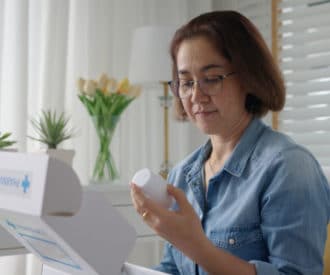
Prescription medications are a significant cost for most seniors. That’s especially true if they fall into the Medicare Part D coverage gap known as the “donut hole.” That’s when drug costs can skyrocket because they’re not covered. FamilyWize shares 5 expert tips on how seniors can afford to pay for prescriptions when they’re in the Medicare donut hole.
For many people, one of the most confusing aspects of using a Medicare drug plan is the coverage gap – sometimes casually referred to as the Medicare “donut hole.”
Each year, the coverage gap spending limits change. And each year, politicians discuss ways to do away with the gap altogether.
The good news is that there is support for seniors – and their caregivers – who fall into this “donut hole” in 2018.
What is the Medicare Part D coverage gap?
The coverage gap is a temporary limit on what a Medicare drug plan will pay for prescription drug coverage.
Within a given year, after a patient and their drug plan have spent a certain amount of money on covered drugs, the coverage gap begins.
Once a patient falls into “the gap,” or “donut hole,” their prescription drug plan will only cover a percentage of their costs and the patient must pay the rest out-of-pocket.
After that, when the patient meets a specific level of out-of-pocket spending for the year, they reach the other side of the donut hole.
Then, they qualify for “catastrophic coverage” until the end of the year. Catastrophic coverage ensures that seniors only pay a small amount for covered drugs for the rest of the year.
Some seniors will never spend enough money on prescription medications to reach this gap. Others reach it and exceed it each year – which means they have to plan ahead for the extra costs.
But planning ahead for the donut hole can be especially tricky for seniors and their caregivers because the spending limits change yearly.
Does the Medicare coverage gap apply to your older adult this year?
In 2018, if an older adult and their plan have spent $3,750 on covered drugs, they are in the coverage gap.
And after spending $5,000 out-of-pocket in 2018, they are out of the coverage gap and automatically qualify for catastrophic coverage.
People with Medicare who are enrolled in the Extra Help program that pays for Part D costs don’t need to worry about the coverage gap.
5 ways to afford prescription drugs when in the “donut hole”
If your older adult might fall into the coverage gap this year, there are several free tools and strategies available to help them afford their prescription drugs:
1. Sign up for a prescription discount card
Signing up for a free prescription discount card is one of the fastest and easiest ways to save a significant amount of money on medication.
Most Rx discount cards are available by free download or mobile app installation. Physical cards can be easily requested as well.
Once you have a prescription discount card for your older adult, simply show it to the pharmacist every time you pick up a prescription.
Look for a card with no fees or eligibility requirements, and check to make sure it covers your senior’s medications and is accepted at your local pharmacies.
2. Download manufacturer coupons
If your older adult uses a brand name drug, it is likely that the pharmaceutical company producing it has a coupon or discount program of some kind.
To find out, visit the drug manufacturer’s official website and look for a “discount program” or “patient assistance” program. Alternatively, try searching for the name of your senior’s medication followed by “manufacturer coupon.” And check to make sure your older adult qualifies for the manufacturer’s coupon discount.
Some states don’t allow discounts to be applied to patients on Medicare and Medicaid. Your pharmacist can help you understand if a manufacturer’s coupon applies.
3. Comparison shop
It’s a common misconception that all pharmacies charge the same amount for the same drug.
They do not.
Taking a few minutes to compare prices among local pharmacies can reveal meaningful savings.
It’s also wise to check major chain and big box stores, as well as independent pharmacies. Large retailers are sometimes able to negotiate deep discounts for commonly prescribed medications.
4. Speak with your doctor or pharmacist about your options
Your older adult’s healthcare providers are very aware that the Medicare Part D coverage gap exists.
If you’re concerned about affording their medications, talk to their doctor and pharmacist right away.
They might be able to suggest a switch to an alternative medication that is lower cost or simply a different dose or treatment plan that can shave a significant amount of money off monthly refill costs.
5. Enroll in government programs
There are also 3 government programs that can help, though they may take a little longer to implement than just downloading a discount card or doing a quick internet search:
Extra Help – If older adults meet certain income requirements, they may qualify for a program that will ensure they never fall into the Medicare coverage gap. Learn more on Medicare.gov.
State Programs – Each state has its own assistance programs to help seniors and their caregivers afford care and treatment. Find your state programs here.
Additional plans – There are many different Medicare plans available, some with better drug coverage than others. Use the Medicare Plan Finder to see if there is one that may be a better fit for your situation.
While the Medicare coverage gap is certainly a challenge, it likely won’t last forever. Policy makers discuss new ways to close the gap every day.
In the meantime, there are programs and strategies available to help seniors and caregivers afford the prescription medications they need.
Recommended for you:
- Medicare Pays for In-Home Care Under the PACE Program
- Medicare Coverage for Hospital Stays: Inpatient vs Outpatient Status
- 6 Common Medication Problems in Seniors and 6 Ways to Solve Them
Guest contributor: Ken Majkowski, Pharm.D, is the Chief Pharmacy Officer at FamilyWize, an organization that provides a free prescription discount card and mobile app to help people better afford their medications, regardless of insurance coverage. Ken brings more than 40 years of healthcare experience to the FamilyWize team, including 14 years of clinical pharmacy experience in retail, hospital, and home care.
Image: HelloCare
This article wasn’t sponsored and doesn’t contain affiliate links. For more information, see How We Make Money.






